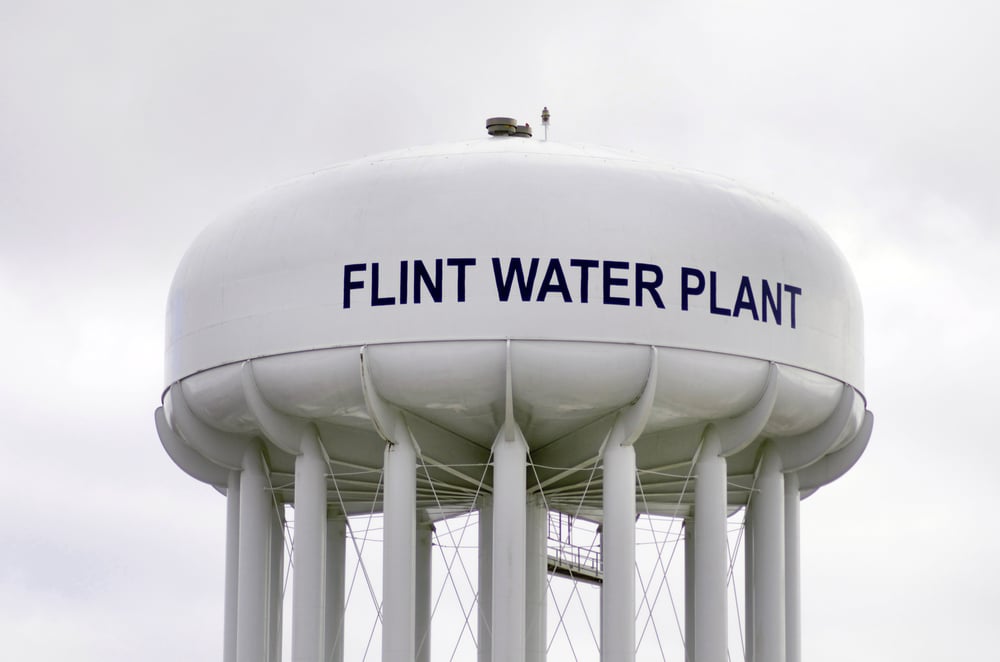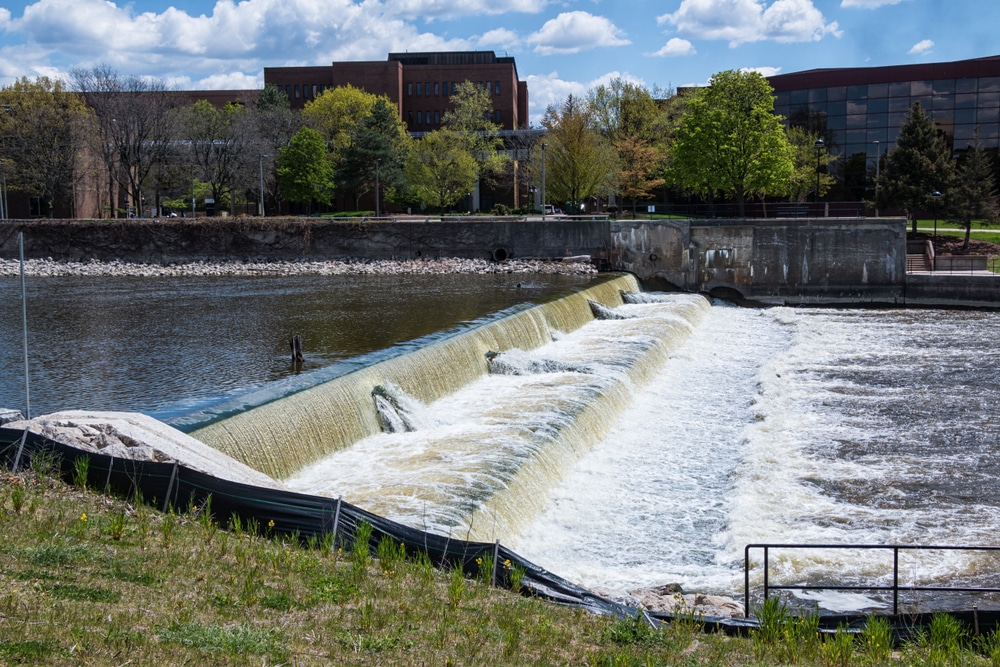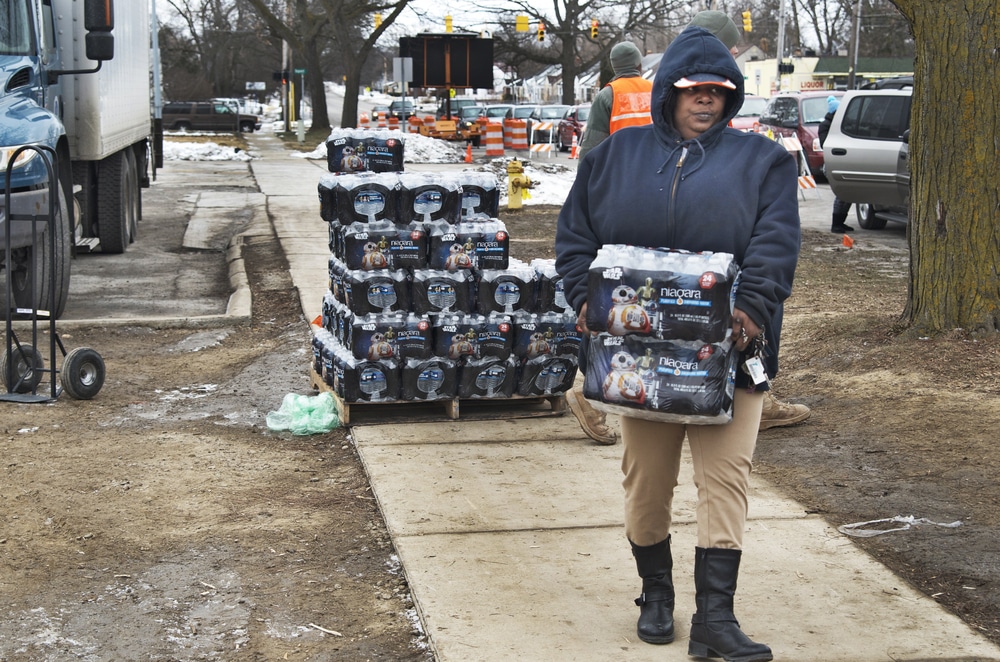In April 2014, Flint, Michigan, changed its water supply from the Detroit Water and Sewage Department (DWSD) to the Karegnondi Water Authority (KWA).
Unfortunately, when the city made the switch, the water distribution pipes started to corrode, leading to one of the worst public health crises the United States had seen to date.
What the Flint Water Crisis was About
In a nutshell, the Flint water crisis had to do with highly toxic levels of lead leaching into the city’s water supply. This was caused by pipe corrosion due to a lack of oversight at the Flint Water Supply Plant.

When Flint switched its water source, the water authorities didn’t perform proper corrosion control tests. These tests would’ve told authorities whether the pipes could hold up to the new water supply.
Had authorities performed the tests, they would’ve seen how corrosive the river water was. Unfortunately, this corrosion caused high levels of lead heavy metal contamination in homes, schools, and businesses across the city.
Lead, which has long been outlawed in things like paint, pipes, and other building materials, is a potent neurotoxin. So when residents began complaining about the water quality in Flint, officials tested some of the water. They found elevated levels of lead in homes, schools, and businesses.
This began a multi-year crisis that’s still making its way through the courts in 2022.
Who Did Flint Water Crisis Affect?
Flint, Michigan, had a population of 100,569 in 2014. According to an early study performed by Virginia Tech students, approximately 40% of the homes in Flint had elevated lead levels.
However, nearly every resident in the city suffered exposure to contaminated water to some degree. The water in homes, schools, and businesses was essentially toxic.
Shortly after the water supply switch, there was an outbreak of Legionnaire disease. This outbreak killed 12 people and is what led officials to check the water for contaminants. But unfortunately, they found insufficient evidence that the water was to blame.
Approximately 18 months after the crisis began, a pediatrician released lead-level findings for Flint. Her results showed that the number of children with elevated lead levels had doubled after the switch. At that point, the state began more rigorous testing to find out exactly how many residents were affected.
In total, around 9,000 children were exposed to dangerously high levels of lead. This is especially troubling due to the damage lead can cause to a developing brain.
What Caused Flint Water Crisis?
Flint had been experiencing financial difficulties for some time when the city manager decided to switch water sources. Getting water from the nearby Flint river was a way to save money. However, the river water was significantly higher in chloride ions than Detroit’s supply.

In fact, it contained eight times more chloride than Lake Huron, which supplied Detroit’s water facility. Before the switch, officials who tested the water in Flint failed to notice these elevated levels due to insufficient water testing.
As a natural corrosive, the chloride ions immediately began to damage the inside of the water supply pipes. That corrosion caused contaminants in the metal to leach into the water.
The chloride in the river was there due to road runoff and waste. Contaminated water coming into the water plant wouldn’t have been as much of an issue if proper protocols were in place to prevent it from causing damage.
Flint Michigan Water Crisis Timeline
Flint’s water crisis began in April of 2014. From that time on, residents relied heavily on bottled or filtered water.
It wasn’t until 2018 that residents saw the return of potable tap water.
When Did the Crisis Start and End?
On April 25, 2014, Flint turned off its connection to the Detroit Water and Sewage Department and officially switched to the Karegnondi Water Authority. Flint’s water supply would now come from the Flint River instead of Lake Huron.
The first of multiple boil-water advisories came in August in response to fecal coliform bacteria in the water supply. The outbreak prompted the city to pump more chlorine into the pipes to kill the bacteria.
Flint officials poured chlorine into the city’s water supply several more times to flush out and eliminate the bacteria. However, chlorine in the presence of water is highly corrosive.
So, although the bacteria was eliminated, the chlorine treatment exacerbated the pipes’ corrosion problem.
After more than a year, in 2015, Governor Rick Snyder signed a bill to reconnect the city to Detroit’s system. This ultimately ended Flint’s connection to the Flint River. However, the corroded pipes that remained were still a problem.
Unfortunately, Flint residents continued to experience toxic lead levels in their water for another four years. It wasn’t until February of 2019 that the water was considered safe to drink.

How Long Did It Last?
The water crisis in Flint lasted nearly 5 years from when the water lines switched until the water was deemed safe again.
Here are a few of the critical events that took place in that period.
- June 2014 – An outbreak of Legionnaire disease started in Flint, killing 12 people and causing 87 to fall ill.
- August 14, 2014 – The first boil-water alert was issued in response to fecal bacteria in the water.
- October 2014 – General Motors cut their connection to Flint’s water supply because the overly-chlorinated water was eroding engine parts.
- December 2014 – Michigan’s Department of Environmental Quality (MDEQ) cites Flint for violating the Safe Drinking Water Act.
- January 2, 2015 – Officials warn residents of cancer-causing chemical byproducts in the water, but states the water is safe for the general population.
- January 12, 2015 – City officials decline DWSD’s offer to reconnect Flint to Detroit’s water free of charge.
- January 2015 – Flint residents lodge their first complaints about poor water quality to the city council.
- February 2015 – Governor Snyder issues a $2 million grant to fix Flint’s water problems.
- February 26, 2015 – The EPA detects toxic levels of lead in the home of Lee-Anne Walters that are nearly 7 times the EPA’s limit.
- March 23, 2015 – Emergency manager Jerry Ambrose overrules a city council vote to reconnect to DWSD’s water, citing potential increases in water costs over time.
- June 24, 2015 – Virginia Tech researchers and water expert Marc Edwards release their findings of lead levels in Flint homes.
- September 24, 2015 – Dr. Mona Hanna-Attisha releases a study showing significant increases in lead levels in children in Flint in the year following the water supply switch.
- October 15, 2015 – Governor Snyder signs a bill to reconnect to Detroit’s system.
- January 24, 2017 – Flint’s water tests below toxic levels for the first time.
Despite reconnecting to Detroit’s water supply, it still took several years before Flint residents had clean water. This is because the pipes going into their homes had become corroded and needed to be replaced.
In the interim, with help from the National Guard and federal aid, Flint residents were able to receive clean water from outside sources.
But, unfortunately, it would be more than a year before the water in Flint would fall below toxic levels and another three before it was potable.
How Lead Got Into Flint Water
There was a bit of a perfect storm when it came to lead contaminating the water in Flint. Due to several environmental and human failures, high levels of lead leached from the main water supply pipes and into the homes and businesses in Flint.
When a city begins using a new water supply, the treatment plant is supposed to perform corrosion testing. This testing will demonstrate whether or not a supply line will be able to hold up to the water running through it.
Municipalities are also supposed to use corrosion prevention methods, usually in the form of phosphates, to ensure a water supply is working correctly.
As stated previously, elevated chloride ions in the Flint River’s water caused excessive corrosion in the city’s water supply pipes. Testing would’ve shown the levels of chloride in the water. As a result, the city could’ve immediately begun corrosion-prevention methods or switched the water supply.
However, because city officials didn’t do sufficient corrosion testing before they started pumping water to Flint residents, they didn’t know the potential damage.
Instead, they continued to treat the water with added chlorine. When that was combined with the chloride in the river water, the corrosion became even worse.
How Much Lead Was in Flint Water
When discussing Flint’s water crisis, it’s essential to know that the EPA has a threshold for how much lead can be present in water.
The specific amount is 15 ppb, or parts per billion. This is the equivalent of 15 micrograms of lead per liter of water. Anything beyond that is toxic waste.
The second threshold to consider is the EPA’s limit for hazardous waste. If lead levels in the water exceed 5,000 ppb, that water would be regarded as hazardous waste.
On February 26th, 2015, the EPA reported lead findings at the home of Lee-Anne Walters. She’d contacted the agency after finding dark sediment in her water. When the EPA visited her home to perform a test, they found lead levels of 104 ppb.
Walters’ pipe system was flushed out less than one month later, and she performed a second test. This test revealed a lead level of 397 ppb, or 26 times the EPA’s threshold. The increase indicated that the issue was the city’s water supply, not Walters’ pipes, as the city had suggested.
On April 28th, Walters’ system was flushed and tested several more times. The highest results showed a lead level of 13,200 ppb, nearly triple the EPA’s threshold for hazardous waste. Although Walters’ home was an outlier, subsequent tests of 271 Flint homes and several samples from Flint Community Schools showed lead levels that constituted toxic waste.
How Long Was Flint Without Clean Water?
It was four years before the water in Flint was drinkable. Despite switching back to DWSD’s water supply in October of 2015, the water in Flint wasn’t considered safe for drinking until February of 2019.
When Governor Snyder declared a state of emergency in Flint in 2015, the government provided free water filters and bottled water to all residents. These were intended to be a stopgap while the damaged pipes were repaired.

As of December of 2020, nearly every home that had been connected to damaged pipes had copper replacements. In addition, water tests showed lead levels below 5 ppb. Although this is above what residents want to see, it’s well below the EPA’s guidelines.
The Effects of Flint Water Crisis
The effects of Flint’s water crisis were far-reaching. There were environmental, legal, and political repercussions, not to mention the near-total loss of trust the residents felt toward their officials.
How It Affected the Environment
Without a doubt, the lasting effects of the Flint water crisis are on the people of Flint. In particular, the children who were exposed to toxic levels of lead. Dr. Hanna-Attisha, the pediatrician who first reported the elevated lead levels in Flint children, said nearly 80% of the children she tested would need special education services due to the effects of lead poisoning.
However, the effects on the environment can’t go without mention. Contaminated water from Flint homes was flushed back into the water supply run and through garden hoses, taking the lead with it.
In other words, the lead in the pipes was pumped out of homes into the water supply and groundwater. There’s no way to know for sure what effect that could have on Flint’s environment going forward.
In 2016, in response to the Flint water crisis, President Obama signed the Water Infrastructure Improvements for the Nation Act. The purpose of this act is to facilitate improvements in the waterways in the United States. When Obama signed the act, he earmarked $174 million for Flint.
Resolution and Settlement
In total, Flint residents and other individuals filed 79 lawsuits during the crisis. The lawsuits were for various reasons, including:
- Personal injury
- Property damage
- Monetary loss
However, the largest lawsuit was a class action suit against the city, state, and various individual entities. It awarded $626 million to Flint residents, which a judge approved in December of 2021.
Children and residents who were under 18 during the crisis will get the bulk of the funds. Approximately 80% is allocated for them, with most of that going to children who were under 6 when they were exposed. The rest will be distributed to adults, property and business owners, and renters.

How Did the Flint Water Crisis Get Resolved?
The Flint water crisis is still ongoing. Although the water is considered safe to drink, infrastructure changes are still underway, as are several lawsuits and legal cases. The most significant repair has been to the infrastructure in Flint.
However, there were more than 30,000 affected pipes connected to the city’s contaminated water supply. Each line needed to be checked, repaired, or replaced, which would take several years to complete.
How Much Did the Crisis Cost?
All told, Flint’s water crisis ended up costing the state, city, and federal governments more than $450 million. This doesn’t include the various settlements that involved monetary payouts. Since the crisis is still ongoing, there will likely be more costs to come.
The funding from the government went toward paying for water filters for individual homes, water tests, bottled water, and infrastructure repairs. The project to replace the lead water pipes throughout the city is set to wrap up in 2022.
Who Pays for the Settlement?
The defendants in the lawsuit include several private and government entities, including the following:
- The State of Michigan
- The Michigan Department of Environment, Great Lakes, and Energy
- The Michigan Department of Health & Human Services
- Governors Richard Snyder and Gretchen Whitmer
- The City of Flint
- McLaren Regional Medical Center
- McLaren Flint Hospital
- Rowe Professional Services Company
Numerous individuals are also included in the list of defendants. These are individuals related to the water plant as well as specific city officials who downplayed the crisis or allegedly falsified information.
The cost of the settlement will be split up in the following way:
- The State of Michigan – $600 million
- The city of Flint – $20 million
- McLaren Hospitals – $5 million
- Rowe Professional Services – $1.25 million
Who Qualifies for Flint Water Settlement?
When Flint residents filed the lawsuit, they outlined specific parameters in order to qualify for the settlement.
Specifically, the settlement included anyone who was exposed to contaminated water from the Flint Water Treatment Plant between April 25th, 2014, and November 16th, 2020.
Anyone who thinks they qualify will need to provide proof of exposure, such as hospital or other medical records.
How Do You Get a Settlement With Flint?
Unfortunately, you can no longer get a settlement with Flint as the deadline for submission closed on the 30th of June, 2022.
Those who qualified and filled out the necessary forms before the deadline can find more details about their status at www.officialflintwatersettlement.com. The website has all of the information relating to the settlement, including contact information for any questions or issues regarding the claims.
To get a settlement with Flint, people had to provide proof of exposure in the form of blood or bone tests. In addition, a cognitive test and certain hospital records, such as birth certificates, were required in certain instances.
The Way Forward
In 2023, Flint is still working to move forward after its water crisis. Although it was a preventable catastrophe, life is slowly returning to a new normal.
What Has Been Done about the Flint Water Crisis?
The city entered a long infrastructure plan to replace hundreds of pipes leading into people’s homes to completely re-do the water supply that goes into the homes of Flint residents. The city has also installed five monitoring stations that provide analysis of the water throughout the whole city.
Where Does Flint Get Their Water Now?
In 2017, the city of Flint signed a 30-year contract with Detroit’s Great Lakes Water Authority to use Lake Huron as the primary water source.
Does Flint Have Clean Water in 2023?
Yes, Flint has clean water in 2023. The latest water quality reports show lead levels are below the action limit set by the Environmental Protection Agency. No samples have a value above the actionable threshold (15 ppb).
In addition, as of late 2022, the city was in the final phase of its piping system renewal project targeting the remaining 1,600 water service lines, having replaced 10,059 lead and galvanized lines and inspected 27,133 service lines. As the replacements draw to a close, the Flint water quality is likely to increase.However, although the EPA sets the action level on lead at 15 ppb, it also establishes that there is no safe level of lead exposure through drinking water. If you are concerned about the presence of lead in your water, consider installing a lead water filter.